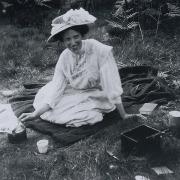Whilst the likes of Ronnie O’ Sullivan, Stephen Hendry and Steve Davis are now revered legends of the game, it is Derbyshire’s Joe Davis who was the dominant figure in world snooker and billiards for over three decades.
Long before the days of TV’s Pot Black, he is credited with changing the way snooker is played, introducing many previously unknown skills such as tactical break building.
In the years prior to BBC TV’s Pot Black giving the game its worldwide popularity, Davis won the first 15 World Snooker Championships from 1927 to 1946, and he remains the only undefeated player in World Championship history, surely a record which will remain unsurpassed.
He was also World Billiards Champion four times between 1928 and 1932 and was the first person to win both billiards and snooker world titles.
Other than in handicapped matches (where he gave his opponent a start), Davis only ever lost four times, all towards the end of his career – and all against his younger brother Fred.
Legendary TV commentator Clive Everton once described Davis’s domination of and early influence on snooker.
‘In those days, the prevailing idea was to pot a red or two, a couple of colours and play safe. But in the time he could spare from billiards, Davis devoted considerable thought and practice to evolving the positional and break-building shots – sequences and techniques which are taken for granted today.’

Joe Davis was born in the east Derbyshire former coal mining village of Whitwell on April 15 1901, the eldest of six children of coalminer and pub landlord Fred Davis and his wife Ann-Eliza. The modest redbrick house on Welbeck Street in Whitwell where he was born now bears a commemorative plaque.
Davis learnt to play billiards in the billiard room of The Queen’s Hotel, his family’s pub in Whittington Moor, where he was coached by local player, Ernest Rudge.
He made a century break in billiards at the age of 12 and won the Chesterfield and District Championship at the tender age of 13.
Davis could not focus properly with his right eye, so he played using a stance in which he rested the cue slightly to the left side of his chin, allowing him to sight along the cue with just his left eye.
Rudge tried to change Davis’s stance to make him play using both eyes but, since Davis could not naturally play this way, they decided not to persist in trying to alter his unique style, which was to bring him his unprecedented success as a player.
In 1919, at the tender age of 18, Davis first became a professional billiards player. In 1922, he won the Midlands Counties Billiards Championship, and victory in the Second Division championship later that year gave Davis entry into the Billiards Association and Control Council Professional Championship.
After three attempts, in 1928 Davis finally beat defending champion Tom Newman in the final of the Professional Billiards Championship – making 60 centuries in what was the last final to be played with ivory balls.
Modern balls are made with a plastic resin, which gives the player more control. Davis went on to successfully defended his billiard championship for the next three years.
He had achieved his highest-ever break in billiards of 2,501 in the 1927 final, using the recently-introduced pendulum stroke.
This technique involves scoring long runs of close direct cannons by tapping the cue ball lightly across them. At the time, there were calls for this stroke to be limited or abolished because it was tedious to watch.
Later that year, the Billiards Association Control Council decided to alter the rules to eliminate the big breaks made from ball-to-ball cannons alone.

The number of consecutive direct cannons allowed during a break was limited to 35, and the pendulum stroke was defined as being in the category of the direct cannon.
The change in the rules didn’t make much difference to Davis. He made a break of 1,011 in 1927 in a match against Newman; the first 1,000 break made under the new rules. Davis won by 485 points in this match of the first to 16,000, after being given a 2,000 start.
At the same time as Davis’s peak as a billiards player, public interest in billiards was waning because the top players were becoming so proficient that the game began to start to be considered boring.
By 1924, breaks of over 1,000 were becoming increasingly common, and amendments to the rules were under consideration to make higher breaks more difficult.
Davis persuaded the Billiards Association and Control Council to recognise an official professional snooker championship in the 1926–27 season.
Davis won the inaugural tournament in 1927 – winning the princely sum of £6 10s. (£6.50) for his efforts. By comparison and in sharp contrast, the Belgian player Luca Brecel’s prize money as the 2023 World Champion was £500,000, and the total prize money for the tournament was £2,395,000.
Davis went on to win the world snooker championship every year until 1940, making the championship’s first official century break in 1930.
The 1940 final was contested between Joe Davis and his younger brother Fred, with Joe winning the match. But Fred remained the only person ever to beat Davis in a competitive snooker match without receiving a start.
In 1946, Davis successfully defended his title, his 15th consecutive win, completing a record 20 years as world champion. To date, he has won more world championships than any other player. He retired in 1946 as the only undefeated player in the history of the world championships.
That same year, Davis had been in attendance at Wembley to watch his beloved Derby County beat Charlton Athletic in the FA Cup Final. He had even been invited into the dressing room before the match to deliver a good luck message, such was his status.
Davis made the first officially recognised maximum break of 147 in 1955 in an exhibition match at Leicester Square Hall, and in 1962 at the age of 60, he made the first century break recorded in front of television cameras.
Davis was awarded the Order of the British Empire (OBE) for his services to the sport in 1963, and he continued to play professionally until 1964. He was also lauded for raising significant money for various charities.
But even in retirement, he continued to exert considerable influence over the game as co-owner of the Leicester Square Hall venue, through his chairmanship of the professional players’ association, and in the negotiation of lucrative television contracts.
Clive Everton wrote that, following his retirement from the world championship, Davis ‘…controlled the game through the force of his personality.’
Davis was variously nicknamed ‘Mr Snooker’, ‘the Sultan of Snooker’ and ‘the Emperor of Pot’ – although the latter title might be misconstrued today!

Davis married Florence Enid Stevenson at Chesterfield Methodist Church in 1921, and the couple had two children. The marriage was dissolved in 1931 and in 1945 he married Juanita Ida Triggs, a singer who performed under the stage name of June Malo.
Davis collapsed while watching his brother Fred play Perrie Mans in the semi-final of the 1978 World Snooker Championship. During his convalescence, he contracted a chest infection which led to his death two months later at the age of 77.
Following in the footsteps of his illustrious brother, Fred Davis became the second person to become a world champion at both snooker and billiards.
Summing up Joe’s stellar career, Fred, who died in 1998 at the age of 84, said his brother was ‘…a very good player before anyone else knew how to play the game.’



























